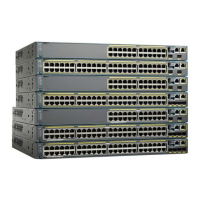•
Dynamic ARP inspection is an ingress security feature; it does not perform any egress checking.
•
Dynamic ARP inspection is not effective for hosts connected to switches that do not support dynamic
ARP inspection or that do not have this feature enabled. Because man-in-the-middle attacks are limited
to a single Layer 2 broadcast domain, separate the domain with dynamic ARP inspection checks from
the one with no checking. This action secures the ARP caches of hosts in the domain enabled for dynamic
ARP inspection.
•
Dynamic ARP inspection depends on the entries in the DHCP snooping binding database to verify
IP-to-MAC address bindings in incoming ARP requests and ARP responses. Make sure to enable DHCP
snooping to permit ARP packets that have dynamically assigned IP addresses.
When DHCP snooping is disabled or in non-DHCP environments, use ARP ACLs to permit or to deny
packets.
•
Dynamic ARP inspection is supported on access ports, trunk ports, and EtherChannel ports.
Do not enable Dynamic ARP inspection on RSPAN VLANs. If Dynamic ARP inspection
is enabled on RSPAN VLANs, Dynamic ARP inspection packets might not reach the
RSPAN destination port.
Note
•
A physical port can join an EtherChannel port channel only when the trust state of the physical port and
the channel port match. Otherwise, the physical port remains suspended in the port channel. A port
channel inherits its trust state from the first physical port that joins the channel. Consequently, the trust
state of the first physical port need not match the trust state of the channel.
Conversely, when you change the trust state on the port channel, the switch configures a new trust state
on all the physical ports that comprise the channel.
•
The rate limit is calculated separately on each switch in a switch stack. For a cross-stack EtherChannel,
this means that the actual rate limit might be higher than the configured value. For example, if you set
the rate limit to 30 pps on an EtherChannel that has one port on switch 1 and one port on switch 2, each
port can receive packets at 29 pps without causing the EtherChannel to become error-disabled.
•
The operating rate for the port channel is cumulative across all the physical ports within the channel.
For example, if you configure the port channel with an ARP rate-limit of 400 pps, all the interfaces
combined on the channel receive an aggregate 400 pps. The rate of incoming ARP packets on
EtherChannel ports is equal to the sum of the incoming rate of packets from all the channel members.
Configure the rate limit for EtherChannel ports only after examining the rate of incoming ARP packets
on the channel-port members.
The rate of incoming packets on a physical port is checked against the port-channel configuration rather
than the physical-ports configuration. The rate-limit configuration on a port channel is independent of
the configuration on its physical ports.
If the EtherChannel receives more ARP packets than the configured rate, the channel (including all
physical ports) is placed in the error-disabled state.
•
Make sure to limit the rate of ARP packets on incoming trunk ports. Configure trunk ports with higher
rates to reflect their aggregation and to handle packets across multiple dynamic ARP inspection-enabled
VLANs. You also can use the ip arp inspection limit none interface configuration command to make
the rate unlimited. A high rate-limit on one VLAN can cause a denial-of-service attack to other VLANs
when the software places the port in the error-disabled state.
Catalyst 2960-X Switch Security Configuration Guide, Cisco IOS Release 15.0(2)EX
244 OL-29048-01
Configuring Dynamic ARP Inspection
Restrictions for Dynamic ARP Inspection
